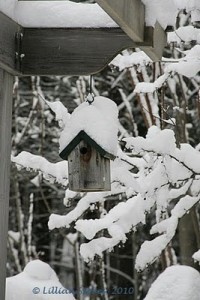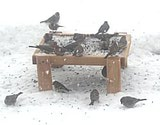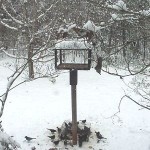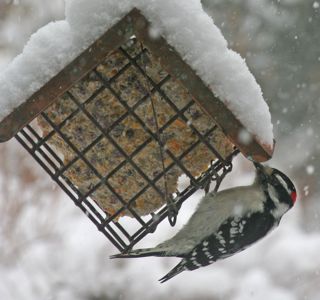Caring for Birds in Winter
Caring for Birds in Winter
 When winter arrives with the bitter temperatures and biting winds, we humans huddle inside with a hot cup of cocoa and a blazing fire in the fireplace. When we go out we don winter coats, hats and gloves. This is how we cope with winter, but what do the birds do? Their feathers are their down parkas and their metabolism keeps them warm but they need increased fuel to stoke their furnaces and shelter from wind and cold.
When winter arrives with the bitter temperatures and biting winds, we humans huddle inside with a hot cup of cocoa and a blazing fire in the fireplace. When we go out we don winter coats, hats and gloves. This is how we cope with winter, but what do the birds do? Their feathers are their down parkas and their metabolism keeps them warm but they need increased fuel to stoke their furnaces and shelter from wind and cold.
Following are some tips from Lillian and Don Stokes, makers of Stokes Bird Feeders, for caring for birds in the cold winter months.
1. Winter can be a difficult time for birds. Wild food sources may be scarce or covered in ice, and birds need more calories to keep warm. Keeping your bird feeders full and available can be very helpful to birds in cold & severe weather.
2. Depending on how sever or how long a store lasts, it is critical to have feeders available to birds as much as possible. Go out frequently and brush off snow and remove ice from feeders, including in the feeder portals. If possible, do this several times during the snow storm and as soon as possible after the storm stops.
 3. Some birds, such as Juncos, Mourning Doves, and White-throated and White-crowned Sparrows prefer to feed on the ground. Make sure you shovel the snow out below the feeder; this allows fallen seed from the feeder to be available to these ground-feeding species. You can also sprinkle a little seed on the ground or place seed in a platform feeder for these birds.
3. Some birds, such as Juncos, Mourning Doves, and White-throated and White-crowned Sparrows prefer to feed on the ground. Make sure you shovel the snow out below the feeder; this allows fallen seed from the feeder to be available to these ground-feeding species. You can also sprinkle a little seed on the ground or place seed in a platform feeder for these birds.
4. Keep feeders full at all times. Birds feed especially heavily at the end of the day to stock up on calories to get them through the night. They then feed first thing in the morning to replenish calories lost during the cold night. It is especially good if feeders are full for them during these times.
 5. Place feeders in sheltered locations or near cover, such as evergreens. Birds seek shelter as they come and go from the feeders.
5. Place feeders in sheltered locations or near cover, such as evergreens. Birds seek shelter as they come and go from the feeders.
6. Choose feeders that have a large seed capacity. This helps if you cannot get out to fill your feeders as often because of sever weather and there will still be seed available for the birds.
7. Choose feeders with overhands that shelter the seed. You can also get baffles (wide plastic or metal circles) and hang them above the feeder. This will help to keep snow off the feeders.
 8. Birds need high calorie foods during winter months. Fill feeders with Black Oil Sunflower and use suet cakes. These foods contain a high amount of fat so they are good calorie-rich food options.
8. Birds need high calorie foods during winter months. Fill feeders with Black Oil Sunflower and use suet cakes. These foods contain a high amount of fat so they are good calorie-rich food options.
Taking care of your feeders in the winter months is rewarding. You will see lots of birds as they come more frequently to your feeders. It will cheer you up and bring color and activity to your yard. Plus, you will have the reward of knowing you are helping the birds survive during these cold months.


